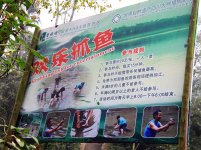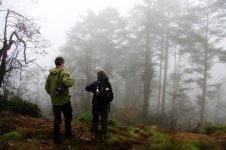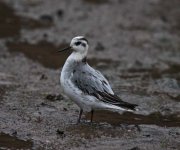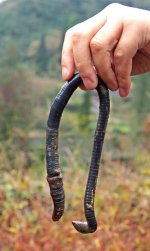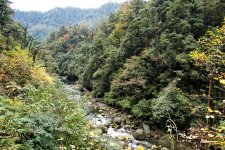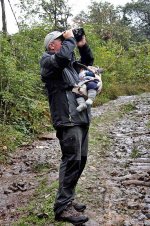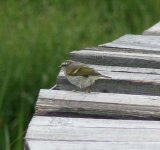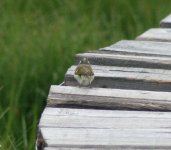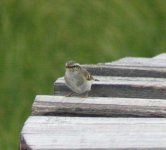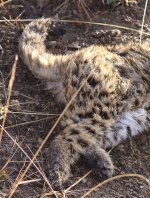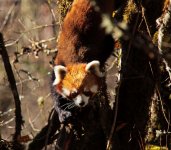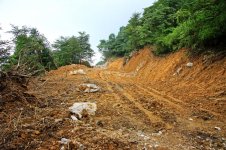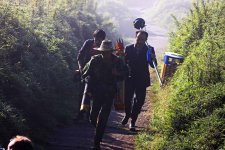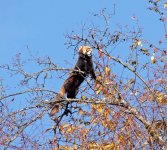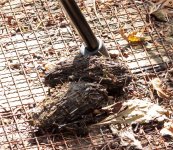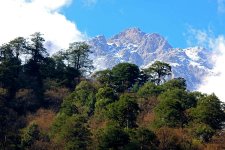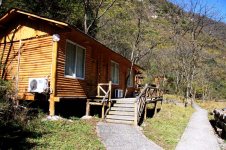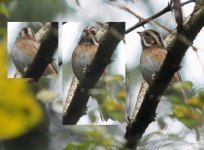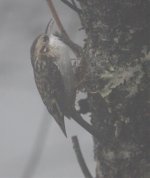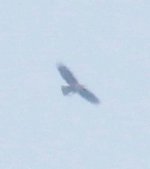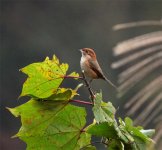-
Welcome to BirdForum, the internet's largest birding community with thousands of members from all over the world. The forums are dedicated to wild birds, birding, binoculars and equipment and all that goes with it.
Please register for an account to take part in the discussions in the forum, post your pictures in the gallery and more.
You are using an out of date browser. It may not display this or other websites correctly.
You should upgrade or use an alternative browser.
You should upgrade or use an alternative browser.
Sichuan Birding (5 Viewers)
- Thread starter china guy
- Start date
More options
Who Replied?china guy
A taff living in Sichuan
Here's the list from our second October trip - a short three day trip, which because of a last day evening train departure to Lhasa, the trip falling over a weekend, my client's non-birding Wife who was most interested in getting Red Panda and the fact that the main Wawu park is now closed until Dec. 10th for a cable car check - needed some careful consideration.
Our solution was the West side of Wawu - a remote forest area outside the main tourist zone. It gave some great birds - for me, actual sightings (as opposed to mouse like silhouettes scuttling through the bamboo) of Grey-sided and Chestnut crowned Bush Warbler were highlights - but the ease in which we found Grey Hooded Parrotbill was also a big plus (now recorded on three visits to this area). And we got our Red Panda!!!!
We'd actually walked a near combined 10km up and down the main trail in search of the animal - without even any skat signs, which are normally easy to find - only, on the way back to find a Red Panda 'perched' in a roadside tree just 30m from our car.
In such, super jammy, circumstances I'm sure guests make a quick scan over the animals to make sure there are no aerials, wires or other signs of a remote control system!!!!!!!!!!!!!!!!!!!!!!!!
The other funny incident was our encounter with the Chesnut-crowned Bush Warbler. I've already written on the Grey-sided Bush Warbler that only came out to a Tesia song - an incident that promoted a conversation over calling out our Sichuan Cettia. Abberant Bush Warbler, common on Wawu during the summer, came up as a subject. I told about a Xeno-canto recording of Chestnut-crowned Bush Warbler where after every Chestnut-crowned song phrase an Aberrant pipes up
http://www.xeno-canto.org/species/Cettia-major - the Nick Athanas recording
- and how first using this recording (on Emei) I was excited at the number of birds, which I was thought to be Chestnut-crowned, coming in - only to be surrounded by Aberrant!!!!!
However we got an opposite result this weekend. Playing the call a Bush Warbler immediately began to rustle in the nearby bamboo - and I of course commented that again we've surely got ourselves an Aberrant - only to be proved totally wrong with a very open and confiding Chesnut-crowned!!!!!!!
The only time I've got this bird with this recording - and we never did find an Aberrant.
By the way my client's wife must have thought we'd totally gone around the bend with our deep discussions on Bush-warbler habits - but luckily she was very understanding and didn't ridicule us too much.
And on the subject of mirth - picture 1 is a candidate for the funniest sign of the year. Found at Bifeng - Fish Grabbing for entertainment - surely the highly satisfied countenance of the successful fish grabber, suggests this activity could be the new 'in-thing.' I'm just wondering if the fish - in a rather mancky concrete pond which acts as the grabbing waters - are smiling quite as much as their manic hunters.
The other pic is of my clients at the Red Panda location (the nearest tree) - of course I'd left my camera in the car, and the time it took to fetch meant the animal had moved. Luckily the other two have nice pictures - which I'll post once they 'filter' through from Lhasa.
However my pic shows the misty weather we suffered - but far rather be on this side of the mountain in the mist than the main Wawu park. And over that weekend - in a country of 1.3billion - not one person seen on our West of Wawu birding/red panda route!!!!!!!
Of course Bifeng was another case - but being a Monday this site wasn't that crowded. Bifeng has a Panda Center with lots of Giant panda for the those less interested in the birds, a very picturesque gorge area and some good birding (Forktails can be good here - although we only got 2 out of 4 possible species).
the list
Sichuan 29th – 31st October 2012 – 3 day trip list
Peter and Heather Humphries, Sid Francis
Day 1 – Drive from Chengdu 5.00 to West side of Wawu – slept at local hotel
Day 2 – West side of Wawu – slept Ya’an
Day 3 – Bifengxia – drive back to Chengdu for my guests to catch 21.00 train to Lhasa
1. Lady Amherst’s Pheasant Chrysolophus amherstiae – day 2 – 3 evening females
2. Grey-capped Woodpecker Dendrocopos canicapillus - 2, 3
3. Crimson-breasted Woodpecker Dendrocopos cathpharius – 1, 2
4. Darjeeling Woodpecker Dendrocopos darjellensis – 1
5. Bay Woodpecker Blythipicus pyrrhotis – 1,2
6. Grey-headed Woodpecker Picus canus - 3
7. Himalayan Swiftlet Collocalia brevirostris - 1
8. Speckled Wood Pigeon Columba hodgsonii – 1
9. Spotted Dove Streptopelia chinensis – 3
10. Crested Goshawk Accipiter trivirgatus – 1 – female, great scope views
11. Eastern Buzzard Buteo japonicas – 1, 3 – Many in the Sichuan basin this autumn
12. Little Egret Egretta garzetta – 1, 3
13. Chinese Pond-Heron Ardeola bacchus – 1
14. Red-billed Blue Magpie Urocissa erythrorhyncha – 1, 2
15. Eurasian Jay Garrulus glandarius – 1, 2
16. Grey Treepie Dendrocitta formosae - 3
17. Long-tailed Minivet Pericrocotus ethologus - 1, 2 - Minivet flocks presumed to be this species
18. Brown Dipper Cinclus pallasii – 3
19. Long-tailed Thrush Zoothera dixoni – 1 – single bird
20. Scaly Thrush Zoothera dauma – 2 – three birds
21. Vivid Niltava Niltava vivida - 1 – single non descript female
22. Himalayan Bluetail Tarsiger rufilatus – 1, 2
23. Golden Bush-Robin Tarsiger chrysaeus – 2 – single female
24. Daurian Redstart Phoenicurus auroreus – 1, 2
25. Blue-fronted Redstart Phoenicurus frontalis – 1, 2
26. White-capped Water-Redstart Chaimarrornis leucocephalus – 1, 2, 3
27. Plumbeous Water-Redstart Rhyacornis fuliginosus – 1, 2, 3
28. Little Forktail Enicurus scouleri – 3
29. Slaty-backed Forktail Enicurus schistaceus - 3
30. Grey Bushchat Saxicola ferrea - 1
31. Chestnut-vented Nuthatch Sitta nagaensis – 1, 2
32. Wren Troglodytes troglodytes – 1, 2
33. Per David’s Tit Poecile davidi - 2 – large flock
34. Coal Tit Periparus ater – 1
35. Yellow-bellied Tit Slyviparus venustulus – 1, 2, 3
36. Eastern Great Tit Parus minor – 1, 2
37. Green-backed Tit Parus monticolus – 1, 2, 3
38. Yellow-browed Tit Sylviparus modestus – 1, 2, 3
39. Eurasian Crag-Martin Hirundo rupestris - 1
40. Black Bulbul Hypsipetes leucocephalus – 3
41. Yellowish-bellied Bush Warbler Cettia acanthizoides – 2
42. Brown –flanked Bush Warbler Cettia fortipes – 3
43. Chestnut-crowned Bush-Warbler Cettia major – 2 - single bird responded/came out to call
44. Grey-sided Bush-Warbler Cettia brunnifrons - 1 - single bird responded/came out to call
45. Eastern Lemmon-rumped (Sichuan ) Leaf Warbler Phylloscopus forresti – 1,, 2, 3 – commonest phyllo
46. Chinese Leaf-Warbler Phylloscopus yunnanensis – 1, 2 – a few together with forresti
47. Pallas’s Leaf Warbler Phylloscopus proregulus – 2, 3 – first this winter
48. Buff-barred Warbler Phylloscopus pulcher – 2, 3
49. Spotted Laughingthrush Garrulax ocellatus - 1
50. Elliot's Laughingthrush Garrulax elliotii – 1, 2
51. Hwamei Garrulax canorus – 3 -heard only Bifeng
52. Black-faced Laughingthrush Garrulax affinis - 2
53. Emei Shan Liocichla Liocichla omeiensis - 1, 2
54. Black-streaked Scimitar Babbler Pomatorhinus gravivox - Heard only - 3
55. Streak-breasted Scimitar Babbler Pomatorhinus ruficollis - 1, 2, 3
56. Rufous-capped Babbler Stachyris ruficeps - 1, 2, 3
57. Scaly-breasted Wren-Babbler Pnoepyga albiventer –1, 2, 3 – heard only
58. Pygmy Wren-Babbler Pnoepyga pusilla – 1, 2, 3 – one seen
59. Red-billed Leiothrix Leiothrix lutea - 1, 2, 3
60. Green Shrike-Babbler Pteruthius xanthochlorus – 1
61. Red-tailed Minla Minla ignotincta - 3
62. Golden-breasted Fulvetta Alcippe chrysotis - 2
63. Grey-hooded Fulvetta Alcippe cinereiceps – 1, 2
64. Dusky Fulvetta Alcippe brunnea – 3
65. David’s Fulvetta Alcippe davidi – 1, 3
66. White-collared Yuhina Yuhina diademata – 1, 2
67. Great Parrotbill Conostoma aemodium – 1, 2
68. Three-toed Parrotbill Paradoxornis paradoxus – 2
69. Ashy-throated Parrotbill Paradoxornis alphonsianus - 1
70. Grey-hooded Parrotbill Paradoxornis zappeyi – 2 – groups at the very top of main track
71. White Wagtail Motacilla alba – 1, 2, 3
72. Grey Wagtail Motacilla cinerea – 3
73. Olive-backed Pipit Anthus hodgsoni – 1, 2,
74. Rufous-breasted Accentor Prunella strophiata – 1, 2
75. Red Crossbill Loxia curvirostra – 1 – winter flocks
76. Little Bunting Emberiza pusilla – 1
Mammals
Red Panda – single animal half way up main track
Pallas's Squirrel - Bifeng
Our solution was the West side of Wawu - a remote forest area outside the main tourist zone. It gave some great birds - for me, actual sightings (as opposed to mouse like silhouettes scuttling through the bamboo) of Grey-sided and Chestnut crowned Bush Warbler were highlights - but the ease in which we found Grey Hooded Parrotbill was also a big plus (now recorded on three visits to this area). And we got our Red Panda!!!!
We'd actually walked a near combined 10km up and down the main trail in search of the animal - without even any skat signs, which are normally easy to find - only, on the way back to find a Red Panda 'perched' in a roadside tree just 30m from our car.
In such, super jammy, circumstances I'm sure guests make a quick scan over the animals to make sure there are no aerials, wires or other signs of a remote control system!!!!!!!!!!!!!!!!!!!!!!!!
The other funny incident was our encounter with the Chesnut-crowned Bush Warbler. I've already written on the Grey-sided Bush Warbler that only came out to a Tesia song - an incident that promoted a conversation over calling out our Sichuan Cettia. Abberant Bush Warbler, common on Wawu during the summer, came up as a subject. I told about a Xeno-canto recording of Chestnut-crowned Bush Warbler where after every Chestnut-crowned song phrase an Aberrant pipes up
http://www.xeno-canto.org/species/Cettia-major - the Nick Athanas recording
- and how first using this recording (on Emei) I was excited at the number of birds, which I was thought to be Chestnut-crowned, coming in - only to be surrounded by Aberrant!!!!!
However we got an opposite result this weekend. Playing the call a Bush Warbler immediately began to rustle in the nearby bamboo - and I of course commented that again we've surely got ourselves an Aberrant - only to be proved totally wrong with a very open and confiding Chesnut-crowned!!!!!!!
The only time I've got this bird with this recording - and we never did find an Aberrant.
By the way my client's wife must have thought we'd totally gone around the bend with our deep discussions on Bush-warbler habits - but luckily she was very understanding and didn't ridicule us too much.
And on the subject of mirth - picture 1 is a candidate for the funniest sign of the year. Found at Bifeng - Fish Grabbing for entertainment - surely the highly satisfied countenance of the successful fish grabber, suggests this activity could be the new 'in-thing.' I'm just wondering if the fish - in a rather mancky concrete pond which acts as the grabbing waters - are smiling quite as much as their manic hunters.
The other pic is of my clients at the Red Panda location (the nearest tree) - of course I'd left my camera in the car, and the time it took to fetch meant the animal had moved. Luckily the other two have nice pictures - which I'll post once they 'filter' through from Lhasa.
However my pic shows the misty weather we suffered - but far rather be on this side of the mountain in the mist than the main Wawu park. And over that weekend - in a country of 1.3billion - not one person seen on our West of Wawu birding/red panda route!!!!!!!
Of course Bifeng was another case - but being a Monday this site wasn't that crowded. Bifeng has a Panda Center with lots of Giant panda for the those less interested in the birds, a very picturesque gorge area and some good birding (Forktails can be good here - although we only got 2 out of 4 possible species).
the list
Sichuan 29th – 31st October 2012 – 3 day trip list
Peter and Heather Humphries, Sid Francis
Day 1 – Drive from Chengdu 5.00 to West side of Wawu – slept at local hotel
Day 2 – West side of Wawu – slept Ya’an
Day 3 – Bifengxia – drive back to Chengdu for my guests to catch 21.00 train to Lhasa
1. Lady Amherst’s Pheasant Chrysolophus amherstiae – day 2 – 3 evening females
2. Grey-capped Woodpecker Dendrocopos canicapillus - 2, 3
3. Crimson-breasted Woodpecker Dendrocopos cathpharius – 1, 2
4. Darjeeling Woodpecker Dendrocopos darjellensis – 1
5. Bay Woodpecker Blythipicus pyrrhotis – 1,2
6. Grey-headed Woodpecker Picus canus - 3
7. Himalayan Swiftlet Collocalia brevirostris - 1
8. Speckled Wood Pigeon Columba hodgsonii – 1
9. Spotted Dove Streptopelia chinensis – 3
10. Crested Goshawk Accipiter trivirgatus – 1 – female, great scope views
11. Eastern Buzzard Buteo japonicas – 1, 3 – Many in the Sichuan basin this autumn
12. Little Egret Egretta garzetta – 1, 3
13. Chinese Pond-Heron Ardeola bacchus – 1
14. Red-billed Blue Magpie Urocissa erythrorhyncha – 1, 2
15. Eurasian Jay Garrulus glandarius – 1, 2
16. Grey Treepie Dendrocitta formosae - 3
17. Long-tailed Minivet Pericrocotus ethologus - 1, 2 - Minivet flocks presumed to be this species
18. Brown Dipper Cinclus pallasii – 3
19. Long-tailed Thrush Zoothera dixoni – 1 – single bird
20. Scaly Thrush Zoothera dauma – 2 – three birds
21. Vivid Niltava Niltava vivida - 1 – single non descript female
22. Himalayan Bluetail Tarsiger rufilatus – 1, 2
23. Golden Bush-Robin Tarsiger chrysaeus – 2 – single female
24. Daurian Redstart Phoenicurus auroreus – 1, 2
25. Blue-fronted Redstart Phoenicurus frontalis – 1, 2
26. White-capped Water-Redstart Chaimarrornis leucocephalus – 1, 2, 3
27. Plumbeous Water-Redstart Rhyacornis fuliginosus – 1, 2, 3
28. Little Forktail Enicurus scouleri – 3
29. Slaty-backed Forktail Enicurus schistaceus - 3
30. Grey Bushchat Saxicola ferrea - 1
31. Chestnut-vented Nuthatch Sitta nagaensis – 1, 2
32. Wren Troglodytes troglodytes – 1, 2
33. Per David’s Tit Poecile davidi - 2 – large flock
34. Coal Tit Periparus ater – 1
35. Yellow-bellied Tit Slyviparus venustulus – 1, 2, 3
36. Eastern Great Tit Parus minor – 1, 2
37. Green-backed Tit Parus monticolus – 1, 2, 3
38. Yellow-browed Tit Sylviparus modestus – 1, 2, 3
39. Eurasian Crag-Martin Hirundo rupestris - 1
40. Black Bulbul Hypsipetes leucocephalus – 3
41. Yellowish-bellied Bush Warbler Cettia acanthizoides – 2
42. Brown –flanked Bush Warbler Cettia fortipes – 3
43. Chestnut-crowned Bush-Warbler Cettia major – 2 - single bird responded/came out to call
44. Grey-sided Bush-Warbler Cettia brunnifrons - 1 - single bird responded/came out to call
45. Eastern Lemmon-rumped (Sichuan ) Leaf Warbler Phylloscopus forresti – 1,, 2, 3 – commonest phyllo
46. Chinese Leaf-Warbler Phylloscopus yunnanensis – 1, 2 – a few together with forresti
47. Pallas’s Leaf Warbler Phylloscopus proregulus – 2, 3 – first this winter
48. Buff-barred Warbler Phylloscopus pulcher – 2, 3
49. Spotted Laughingthrush Garrulax ocellatus - 1
50. Elliot's Laughingthrush Garrulax elliotii – 1, 2
51. Hwamei Garrulax canorus – 3 -heard only Bifeng
52. Black-faced Laughingthrush Garrulax affinis - 2
53. Emei Shan Liocichla Liocichla omeiensis - 1, 2
54. Black-streaked Scimitar Babbler Pomatorhinus gravivox - Heard only - 3
55. Streak-breasted Scimitar Babbler Pomatorhinus ruficollis - 1, 2, 3
56. Rufous-capped Babbler Stachyris ruficeps - 1, 2, 3
57. Scaly-breasted Wren-Babbler Pnoepyga albiventer –1, 2, 3 – heard only
58. Pygmy Wren-Babbler Pnoepyga pusilla – 1, 2, 3 – one seen
59. Red-billed Leiothrix Leiothrix lutea - 1, 2, 3
60. Green Shrike-Babbler Pteruthius xanthochlorus – 1
61. Red-tailed Minla Minla ignotincta - 3
62. Golden-breasted Fulvetta Alcippe chrysotis - 2
63. Grey-hooded Fulvetta Alcippe cinereiceps – 1, 2
64. Dusky Fulvetta Alcippe brunnea – 3
65. David’s Fulvetta Alcippe davidi – 1, 3
66. White-collared Yuhina Yuhina diademata – 1, 2
67. Great Parrotbill Conostoma aemodium – 1, 2
68. Three-toed Parrotbill Paradoxornis paradoxus – 2
69. Ashy-throated Parrotbill Paradoxornis alphonsianus - 1
70. Grey-hooded Parrotbill Paradoxornis zappeyi – 2 – groups at the very top of main track
71. White Wagtail Motacilla alba – 1, 2, 3
72. Grey Wagtail Motacilla cinerea – 3
73. Olive-backed Pipit Anthus hodgsoni – 1, 2,
74. Rufous-breasted Accentor Prunella strophiata – 1, 2
75. Red Crossbill Loxia curvirostra – 1 – winter flocks
76. Little Bunting Emberiza pusilla – 1
Mammals
Red Panda – single animal half way up main track
Pallas's Squirrel - Bifeng
Attachments
Last edited:
china guy
A taff living in Sichuan
This weekend, together with family and Roland + daughter, I was again up around the west side of Wawu - this trip turning up one of the my most unexpected Sichuan birding finds.
Of all the birds I could expect to see in this area - on a muddy driving track, well over the 1500m mark - we managed to find - wait for it............................................ Grey Phalarope!!!!!!!!!!!!!!!!
If ya don't believe me - look at the photo
Back home in S Wales, at around 13 years of age, this species revolutionized my early birding after I found one at our local estuary. The fun of finding and pleasure of getting onto the correct ID - proved a big step up my birding ladder. This latest bird was just as ridiculously tame - but, by feeding in gunky puddles half way up a sub-tropical mountain, it obviously didn't display the usual Phalarope ID give-away - swimming in Phalarope circles.
Another fascinating find - and warning to those who don't like slimy slithering beasties not to look at pic 2 - was a Giant Earthworm.
No optical illusions - that worm is as thick as fingers - must be a foot long when extended. I know these worms are seen on Emei - but I couldn't find any real info through the net. Anybody know the scientific name??????
Afraid this trip wasn't trouble free - they're about to do some road building in the area - and we were only allowed into the forest park for one day. Therefore yesterday we visited another site that was new to us - a nearby area that was advertised as being rich in Dove tree Davidia involucrata - http://en.wikipedia.org/wiki/Dove_tree
Getting there we were amazed by the pristine condition of the deciduous forest - the best birds we got here were Moustached Laughingthrush - the craziest (another migrant passing through this mountain range) - a Yellow Bittern.
The last two pics show the habitat - and me together with a student birder, who's sleeping out, on my stomach, yet another close encounter with Golden-breasted Fulvetta.
Of all the birds I could expect to see in this area - on a muddy driving track, well over the 1500m mark - we managed to find - wait for it............................................ Grey Phalarope!!!!!!!!!!!!!!!!
If ya don't believe me - look at the photo
Back home in S Wales, at around 13 years of age, this species revolutionized my early birding after I found one at our local estuary. The fun of finding and pleasure of getting onto the correct ID - proved a big step up my birding ladder. This latest bird was just as ridiculously tame - but, by feeding in gunky puddles half way up a sub-tropical mountain, it obviously didn't display the usual Phalarope ID give-away - swimming in Phalarope circles.
Another fascinating find - and warning to those who don't like slimy slithering beasties not to look at pic 2 - was a Giant Earthworm.
No optical illusions - that worm is as thick as fingers - must be a foot long when extended. I know these worms are seen on Emei - but I couldn't find any real info through the net. Anybody know the scientific name??????
Afraid this trip wasn't trouble free - they're about to do some road building in the area - and we were only allowed into the forest park for one day. Therefore yesterday we visited another site that was new to us - a nearby area that was advertised as being rich in Dove tree Davidia involucrata - http://en.wikipedia.org/wiki/Dove_tree
Getting there we were amazed by the pristine condition of the deciduous forest - the best birds we got here were Moustached Laughingthrush - the craziest (another migrant passing through this mountain range) - a Yellow Bittern.
The last two pics show the habitat - and me together with a student birder, who's sleeping out, on my stomach, yet another close encounter with Golden-breasted Fulvetta.
Attachments
Last edited:
MKinHK
Mike Kilburn

I used to think that my Pheasant-tailed Jacana on the river at Chebaling would be an unbeatable lost wader, but a Grey Phalarope on Wawu . . . takes bizarre to entirely new levels! Add to that the fact it was one of the birds that got going from back home - doen't come much better. - Great stuff Sid!
PS that does loook like good habitat. What altitude is it?
Cheers
Mike
PS that does loook like good habitat. What altitude is it?
Cheers
Mike
James Eaton
Trent Valley Crew
Grey Phal?! That is amazing, and I presume a pretty good China bird!
I would agree with others, that cat resembles Leopard Cat more than anything else, surprising in that habitat though, but I guess it isn't a million miles from extensive tracts of forest and scrub - would explain perhaps a bit of naivety on its part with the roads unfortunately.
Just a quick id query - White-spectacled Warbler at Wuyipeng. The White-spectacleds in southern Sichuan have a yellow eye-ring, not white, and occur, like Kloss's, in just the semi-tropical forests to the south of Sichuan below 1800m...
It is a very common bird in good quality forest (ie Laojunshan, Emei Shan), but almost absent from degraded forests like at Wawu.
Regards and keep up the good work!
James
I would agree with others, that cat resembles Leopard Cat more than anything else, surprising in that habitat though, but I guess it isn't a million miles from extensive tracts of forest and scrub - would explain perhaps a bit of naivety on its part with the roads unfortunately.
Just a quick id query - White-spectacled Warbler at Wuyipeng. The White-spectacleds in southern Sichuan have a yellow eye-ring, not white, and occur, like Kloss's, in just the semi-tropical forests to the south of Sichuan below 1800m...
It is a very common bird in good quality forest (ie Laojunshan, Emei Shan), but almost absent from degraded forests like at Wawu.
Regards and keep up the good work!
James
china guy
A taff living in Sichuan
Just back from a Red Panda trip to a newly opened Labahe with Ian Green of Greentours - 4 Red Pandas, Giant Panda skat, Takin, Blue Sheep, Long-tailed Goral, Samba Deer, David's Macaque - but more on that in my next posts.
That Phalarope was a brilliant find - Roland got a call from a local ornithologist working for the forestry dept.to make sure we weren't pulling legs!!!!!!!
Mike that habitat starts around 1200m mark - such pristine forest at so low altitude is very rare today!!!!! These valleys must have been one of the last hangouts for South China Tiger. Roland told me that the Father of his Chinese teacher, who came from around nearby Ya'an, was missing a leg - lost as a youngster to a Tiger attack. Its seems this magnificent animal was exterminated during the last 50/60 years through massive environmental change. The pockets of natural habitat still left around Wawu give us a clue to how magnificent Sichuan must have once been.
James - I presumed the so-called White-spectacled Warbler was a passage bird - but the White-ring didn't seem as bold as the white-rings I've seen on winter birds in Yunnan.
Another passage Warbler on my list is Ashy-throated Warbler. I only see this species during passage - yet Mackinnon states they breed in Sichuan. Anybody know where the breeding area should be???
Another warbler species we've once recorded during passage is Back-faced Warbler (Wawu 2009) - MacK states they breed around Kangding, but I'm sure this isn't the case today.
I suspect the present, main, breeding ranges of Ash-throated and Black-faced Warbler occur well to the south of the birding areas I regularly frequent, but my recordings indicate that we can also expect a few of them to work their way north - and likewise shouldn't be too surprised if the White-spectacled form of White-spectacled Warbler was to also show up in our patch.
And on the subject of Warblers - my brother in law provided me with some pics that are intriguingly similar to James's Gansu Leaf Warbler in post 483. He took his pics on the very same Ruoergai, Flower Lake boardwalk during the May Holiday of 2009. I only stumbled on these pics - three of which I've put up - a few weeks back.
He'd lent a camera and thought he'd try his hand at bird photography - but had dismissed these pics as total rubbish!!!!!!! Without a call its very difficult to tell if were looking at Eastern Lemon-rumped - or something a little more exciting.
As for that Cat - well I had time to go through my pics - all the pics are of the same angle but this one better shows the paw. I'm also sure its Leopard Cat.
And a last pic - a Red Panda from Yesterday
That Phalarope was a brilliant find - Roland got a call from a local ornithologist working for the forestry dept.to make sure we weren't pulling legs!!!!!!!
Mike that habitat starts around 1200m mark - such pristine forest at so low altitude is very rare today!!!!! These valleys must have been one of the last hangouts for South China Tiger. Roland told me that the Father of his Chinese teacher, who came from around nearby Ya'an, was missing a leg - lost as a youngster to a Tiger attack. Its seems this magnificent animal was exterminated during the last 50/60 years through massive environmental change. The pockets of natural habitat still left around Wawu give us a clue to how magnificent Sichuan must have once been.
James - I presumed the so-called White-spectacled Warbler was a passage bird - but the White-ring didn't seem as bold as the white-rings I've seen on winter birds in Yunnan.
Another passage Warbler on my list is Ashy-throated Warbler. I only see this species during passage - yet Mackinnon states they breed in Sichuan. Anybody know where the breeding area should be???
Another warbler species we've once recorded during passage is Back-faced Warbler (Wawu 2009) - MacK states they breed around Kangding, but I'm sure this isn't the case today.
I suspect the present, main, breeding ranges of Ash-throated and Black-faced Warbler occur well to the south of the birding areas I regularly frequent, but my recordings indicate that we can also expect a few of them to work their way north - and likewise shouldn't be too surprised if the White-spectacled form of White-spectacled Warbler was to also show up in our patch.
And on the subject of Warblers - my brother in law provided me with some pics that are intriguingly similar to James's Gansu Leaf Warbler in post 483. He took his pics on the very same Ruoergai, Flower Lake boardwalk during the May Holiday of 2009. I only stumbled on these pics - three of which I've put up - a few weeks back.
He'd lent a camera and thought he'd try his hand at bird photography - but had dismissed these pics as total rubbish!!!!!!! Without a call its very difficult to tell if were looking at Eastern Lemon-rumped - or something a little more exciting.
As for that Cat - well I had time to go through my pics - all the pics are of the same angle but this one better shows the paw. I'm also sure its Leopard Cat.
And a last pic - a Red Panda from Yesterday
Attachments
Last edited:
china guy
A taff living in Sichuan
Hi H - i actually think we've turned the corner here with the destruction of major habitat - and whenever you turn up in Sichuan there should be a wealth of great birding habitat. The factors that have lined up that now tip the balance on the side of habitat protection - include, tourism as an economic force (keeping things pretty usually associated with protecting habitat), lawmaking that creates vast areas of Panda protection zone, the realization that forest destruction can intensify potential landslide and flood catastrophe - and maybe a cultural change where new generations are slowly realizing a concept over 1st world countries are also defined in international relations by their present-day environmental track-records (Beijing Olympics and filthy Beijing pollution levels must have embarrassed a few people into realising they were living in the kind of environments that could shock foreign visitors).
However not all is light and happiness - some of the folk who runs some of the best birding parks don't seem too professional or enlightened on the subject of conservation. An example is Wawu - where for the last couple years there's been a mad rush to develop the tourist side of their business. Concerned parties have confronted management with worries over habitat destruction through new construction and the vast increase in tourists - but, as far as we know, the park will not deviate on their plans for the future.
The two pictures illustrate how things are going -
1. the present scene where the road has is being extended past the middle hotels to make it one big loop. maybe there's sound logic with this move, since it will relieve the traffic pressure - but why such a huge development footprint where so much of that excavated earth has been dumped down the valley sides to destroy yet more vegetation?????? When approaching the cable-car station you will now see this construction as a large brown scar on the mountain behind the hotel.
2. surveying up on the top of Wawu close to Manadarin Duck Ponds. not really sure what all this is about - but there was one big area where all the bamboo had been cut. This area is important for the rare Grey-hooded Parrotbill - lets hope they'll be able to adapt to any building work here.
Even with development changes there'll still be lots of great bird habitat - and if the worse comes to worst then there's always the other "undiscovered" west side of the mountain. Part of of our quest is finding our way around any changes that start to "complicate" our birding - and luckily we're always finding new places to bird and alternative sites - while hoping the some of the present rush for change will slowly ease off and more of the enlightened will take up the management of Sichuan's fantastic bird-rich parks.
However not all is light and happiness - some of the folk who runs some of the best birding parks don't seem too professional or enlightened on the subject of conservation. An example is Wawu - where for the last couple years there's been a mad rush to develop the tourist side of their business. Concerned parties have confronted management with worries over habitat destruction through new construction and the vast increase in tourists - but, as far as we know, the park will not deviate on their plans for the future.
The two pictures illustrate how things are going -
1. the present scene where the road has is being extended past the middle hotels to make it one big loop. maybe there's sound logic with this move, since it will relieve the traffic pressure - but why such a huge development footprint where so much of that excavated earth has been dumped down the valley sides to destroy yet more vegetation?????? When approaching the cable-car station you will now see this construction as a large brown scar on the mountain behind the hotel.
2. surveying up on the top of Wawu close to Manadarin Duck Ponds. not really sure what all this is about - but there was one big area where all the bamboo had been cut. This area is important for the rare Grey-hooded Parrotbill - lets hope they'll be able to adapt to any building work here.
Even with development changes there'll still be lots of great bird habitat - and if the worse comes to worst then there's always the other "undiscovered" west side of the mountain. Part of of our quest is finding our way around any changes that start to "complicate" our birding - and luckily we're always finding new places to bird and alternative sites - while hoping the some of the present rush for change will slowly ease off and more of the enlightened will take up the management of Sichuan's fantastic bird-rich parks.
Attachments
china guy
A taff living in Sichuan
I'm off out again tomorrow for another 10 days, so last chance, for a bit, to post up a report on that Red Panda trip, which I did with Ian Green and Roger E N Smith.
The trip went to a newly opened Labahe Forest Park (been closed for the last 2 years) - around 6 hours drive from Chengdu - Starting at 7.00am, on 8th Nov. from Holly's Hostel in Chengdu, and returning, to the same hotel, at 7.00pm on the evening of the 10th. Not much time involved but a lot of animals a few birds were packed into this trip, which highlighted, for Red Pandas, and certainly for other mammals, that this site could be as good if not better a destination than Wawu.
With one full and 2 half days at the park - mammal-wise managed to see 4 Red Pandas that, because they were openly daytime feeding on Rose-hip and Spindletree type berries, gave at least 3 hours of combined observation time, a nighttime Takin, that was illuminated and seen at close hand during a spotlighting drive, herds of scoped Blue Sheep, a single Long-tailed Goral (Chinese Goral are our usual Goral species), Numerous Samba Deer (they have a building where can you observe Samba coming down to salt-lick) and troops of David's Macaque. Skat wise we found signs of Giant Panda and Asiatic Black Bear.
The bird front wasn't quite as exciting - we saw Moustached Laughingthrush just outside the Park together with Black-faced Laughers - while inside the park the best birds were female singles of both Lady A Pheasant and Temminck's Tragopan and a Rufous-tailed Moupinia (Babbler). But nothing much very exciting between the common stuff - Elliot's Laugher, Grey-hooded Fulvetta, Nutcracker and White-collared Yuhina. Speckled Wood Pigeon. A single Himalayan Griffon a Himalayan Buzzard , a couple of Blue-fronted Redstart , Chestnut-flanked Nuthatch, Chinese Babax, Yellow-browed Tit, Black-browed Tit, Rufous Vented Tit, Little Forktail and Brown Dipper were also present. no sign of the Streaked Barwing which are in this area - but we see them on the Old Erlang Road which borders the park.
On previous visits, among other stuff, we've found Great and Brown Parrotbill, Red-winged Laugher, Silver Pheasant
Accommodation is very satisfactory. Nowadays only the middle hotel area is open and the best accommodation they have here are Chalets with on-suite, fully working western style toilets and showers. The Chalets are also heated with air-con units and the beds have electric blankets. We rented 2 bed chalets at 320RMB/night - I think they have bigger Chalets with twin bedrooms. There's also a decent restaurant - and a Chinese breakfast comes with the cost of a chalet.
To get to the best animal areas you can either walk 7km to the best daytime viewing area along a driving track - or get one of the park jeeps at 60RMB/person. They wont let private vehicles drive the track. A further 2km takes you to a very long wooden walkway and a circular scenic trek - there's some good walking to be had in the park.
With decent traffic and not too much road-work delay, Labahe is around 6 hours from Chengdu Airport/downtown. During autumn, with the abundance of Red Panda attracting berries, we'd recommend Labahe over Wawu - however, latter in the year, if there was heavy snow in the area it would be best to keep Wawu as an alternative option.
pictures -
1 - a Red Panda demonstrating why this is such a good autumn site - standing to attention while eating berries
2 - we presumed this to be Red Panda skat - with the berry diet a lot different looking than the usual bamboo full droppings we've found at Wawu.
3 - Giant Panda skat - very old, but stil evidence that this mega animal has a presence at Labahe.
4 - Labahe scenery. Some stunning views to had in this park - with a variety of scenery that gives a wide range of habitat. The Blue Sheep were scoped feeding in the grassland zone between Forest and high mountain.
5 - accommodation in the chalets is comfortable
The trip went to a newly opened Labahe Forest Park (been closed for the last 2 years) - around 6 hours drive from Chengdu - Starting at 7.00am, on 8th Nov. from Holly's Hostel in Chengdu, and returning, to the same hotel, at 7.00pm on the evening of the 10th. Not much time involved but a lot of animals a few birds were packed into this trip, which highlighted, for Red Pandas, and certainly for other mammals, that this site could be as good if not better a destination than Wawu.
With one full and 2 half days at the park - mammal-wise managed to see 4 Red Pandas that, because they were openly daytime feeding on Rose-hip and Spindletree type berries, gave at least 3 hours of combined observation time, a nighttime Takin, that was illuminated and seen at close hand during a spotlighting drive, herds of scoped Blue Sheep, a single Long-tailed Goral (Chinese Goral are our usual Goral species), Numerous Samba Deer (they have a building where can you observe Samba coming down to salt-lick) and troops of David's Macaque. Skat wise we found signs of Giant Panda and Asiatic Black Bear.
The bird front wasn't quite as exciting - we saw Moustached Laughingthrush just outside the Park together with Black-faced Laughers - while inside the park the best birds were female singles of both Lady A Pheasant and Temminck's Tragopan and a Rufous-tailed Moupinia (Babbler). But nothing much very exciting between the common stuff - Elliot's Laugher, Grey-hooded Fulvetta, Nutcracker and White-collared Yuhina. Speckled Wood Pigeon. A single Himalayan Griffon a Himalayan Buzzard , a couple of Blue-fronted Redstart , Chestnut-flanked Nuthatch, Chinese Babax, Yellow-browed Tit, Black-browed Tit, Rufous Vented Tit, Little Forktail and Brown Dipper were also present. no sign of the Streaked Barwing which are in this area - but we see them on the Old Erlang Road which borders the park.
On previous visits, among other stuff, we've found Great and Brown Parrotbill, Red-winged Laugher, Silver Pheasant
Accommodation is very satisfactory. Nowadays only the middle hotel area is open and the best accommodation they have here are Chalets with on-suite, fully working western style toilets and showers. The Chalets are also heated with air-con units and the beds have electric blankets. We rented 2 bed chalets at 320RMB/night - I think they have bigger Chalets with twin bedrooms. There's also a decent restaurant - and a Chinese breakfast comes with the cost of a chalet.
To get to the best animal areas you can either walk 7km to the best daytime viewing area along a driving track - or get one of the park jeeps at 60RMB/person. They wont let private vehicles drive the track. A further 2km takes you to a very long wooden walkway and a circular scenic trek - there's some good walking to be had in the park.
With decent traffic and not too much road-work delay, Labahe is around 6 hours from Chengdu Airport/downtown. During autumn, with the abundance of Red Panda attracting berries, we'd recommend Labahe over Wawu - however, latter in the year, if there was heavy snow in the area it would be best to keep Wawu as an alternative option.
pictures -
1 - a Red Panda demonstrating why this is such a good autumn site - standing to attention while eating berries
2 - we presumed this to be Red Panda skat - with the berry diet a lot different looking than the usual bamboo full droppings we've found at Wawu.
3 - Giant Panda skat - very old, but stil evidence that this mega animal has a presence at Labahe.
4 - Labahe scenery. Some stunning views to had in this park - with a variety of scenery that gives a wide range of habitat. The Blue Sheep were scoped feeding in the grassland zone between Forest and high mountain.
5 - accommodation in the chalets is comfortable
Attachments
Last edited:
Terry Townshend
Regular vagrant
Brilliant stuff, Sid. That phalarope is just stupendous!
James Eaton
Trent Valley Crew
Wow, great mammals - very jealous of the Goral! Labahe is somewhere I've been meaning to check out for some time but couldn't due to its closure - keep a look out for barwings there too...
Ashy-throated Warblers are common below Xianfeng at Emei Shan, and Black-faced Warblers also breed there, albeit not so commonly. Further south I have recorded them both, the latter in numbers, at Laojunshan. Like White-spectacled and Kloss's, they require the sub-tropical forests, which I think is too poor in quality now at Wawu Shan to harbour most of these species (Grey-winged Blackbird, Purple Cochoa and Vivid Niltava are three other species that spring to mind).
I have since identified my Flower Lake warbler as a Chinese Leaf Warbler, lack of dark bases to secondaries confirmed that species, unfortunately!
Cheers,
J
Ashy-throated Warblers are common below Xianfeng at Emei Shan, and Black-faced Warblers also breed there, albeit not so commonly. Further south I have recorded them both, the latter in numbers, at Laojunshan. Like White-spectacled and Kloss's, they require the sub-tropical forests, which I think is too poor in quality now at Wawu Shan to harbour most of these species (Grey-winged Blackbird, Purple Cochoa and Vivid Niltava are three other species that spring to mind).
I have since identified my Flower Lake warbler as a Chinese Leaf Warbler, lack of dark bases to secondaries confirmed that species, unfortunately!
Cheers,
J
china guy
A taff living in Sichuan
Thanks for the info James - will certainly now keep eyes (and a call) ready for breeding Black-faced Warbler - the deciduous forest on the West side of Wawu, where we're finding species normally more associated with Emei - would seem a promising area.
As for Labahe - and the Barwing - we've got all our Streaked Barwings on the Old Erlang Road which borders the west side of the park. When are you thinking of making a trip there????
Today, in NE Sichuan, got a bird that should winter in this area - but has been alluding me - Tristram's Bunting
From the stealthy behavior of this male - found in thick scrubby, "gone wild," plantation - I can see why I've waited so long!!!!
As for Labahe - and the Barwing - we've got all our Streaked Barwings on the Old Erlang Road which borders the west side of the park. When are you thinking of making a trip there????
Today, in NE Sichuan, got a bird that should winter in this area - but has been alluding me - Tristram's Bunting
From the stealthy behavior of this male - found in thick scrubby, "gone wild," plantation - I can see why I've waited so long!!!!
Attachments
thirudevaram
Trapped in mist ***s
Hi Sid,
does the eurasian and sichuan treecreeper occur in Mount.Emei? i had a treecreeper at the top but i could not figure it out, it dint make any call but vanished among the passing by coal tits. The pics were very nasty coz of the dense fog. Here is one of the worst pic i managed.
does the eurasian and sichuan treecreeper occur in Mount.Emei? i had a treecreeper at the top but i could not figure it out, it dint make any call but vanished among the passing by coal tits. The pics were very nasty coz of the dense fog. Here is one of the worst pic i managed.
Attachments
china guy
A taff living in Sichuan
Hi Dev,
although call - a sweet trill- is the most certain way of ID'ing Sichuan Treecreeper, your bird looks to be very good for this species.
Buff underparts contrasting with a white chin are the clincher.
The second most common Treecreeper we find in Sichuan is Hodgson's - a split from Eurasian - apart from the call differences from Sichuan, it has very clean white undersides
A description of Hodgson's against Eurasian can be found here - http://en.wikipedia.org/wiki/Hodgson%27s_Treecreeper
I was reading somewhere that gene testing has found Sichuan Treecreeper is more close related to Rusty-flanked than Eurasian.
although call - a sweet trill- is the most certain way of ID'ing Sichuan Treecreeper, your bird looks to be very good for this species.
Buff underparts contrasting with a white chin are the clincher.
The second most common Treecreeper we find in Sichuan is Hodgson's - a split from Eurasian - apart from the call differences from Sichuan, it has very clean white undersides
A description of Hodgson's against Eurasian can be found here - http://en.wikipedia.org/wiki/Hodgson%27s_Treecreeper
I was reading somewhere that gene testing has found Sichuan Treecreeper is more close related to Rusty-flanked than Eurasian.
thirudevaram
Trapped in mist ***s
Thanks a lot Sid, this was the only thing i could be proud of the trip, since wawu was closed, i lost a day travelling to Mount.Emei from wawu.
china guy
A taff living in Sichuan
Hi Dev - if the weather was misty, don't worry too much about missing Wawu - the top can be very difficult in those kind of conditions - and without transport the middle and lower sections can be difficult.
In such circumstances Emei can be a better alternative - especially at this time of year when there can be many flocking birds on lower parts, including areas that don't require ticketed entrance.
For those stuck in a situation of a closed Wawu - it's useful to know there's a country road that will take you between Wawu and Emei that normally takes between 2 to 3 hours (depending on how much road birding you do on the way) - you should be able to travel using local minibuses - that means a trip between the two sites doesn't require two long trips using Chengdu as a bus changeover point.
I'm just back from NE Sichuan - where, apart from that Tristram's Bunting, we had some interesting records.
I think the most pleasing was once again finding our "peg-leg" Bonelli's Eagle - see this post http://www.birdforum.net/showpost.php?p=1805237&postcount=249. Excitingly, it was again flying in a pair. First saw this distinctive bird during Jan. 2010. The way these birds fly in pairs - playing follow my leader between each bout of soaring, circling flight - makes them very easy to ID, even over a great distance.
the pictures -
1 - here's peg-leg - shows also the value of a camera and photoshop - a short, very distant, view, through bins, only gave species. ID'ing of peg-leg had to wait until we got back to a computer.
2 - another decent Sichuan record - Bull-headed Shrike - 2nd bird for this trip and only my 3rd Sichuan record
In such circumstances Emei can be a better alternative - especially at this time of year when there can be many flocking birds on lower parts, including areas that don't require ticketed entrance.
For those stuck in a situation of a closed Wawu - it's useful to know there's a country road that will take you between Wawu and Emei that normally takes between 2 to 3 hours (depending on how much road birding you do on the way) - you should be able to travel using local minibuses - that means a trip between the two sites doesn't require two long trips using Chengdu as a bus changeover point.
I'm just back from NE Sichuan - where, apart from that Tristram's Bunting, we had some interesting records.
I think the most pleasing was once again finding our "peg-leg" Bonelli's Eagle - see this post http://www.birdforum.net/showpost.php?p=1805237&postcount=249. Excitingly, it was again flying in a pair. First saw this distinctive bird during Jan. 2010. The way these birds fly in pairs - playing follow my leader between each bout of soaring, circling flight - makes them very easy to ID, even over a great distance.
the pictures -
1 - here's peg-leg - shows also the value of a camera and photoshop - a short, very distant, view, through bins, only gave species. ID'ing of peg-leg had to wait until we got back to a computer.
2 - another decent Sichuan record - Bull-headed Shrike - 2nd bird for this trip and only my 3rd Sichuan record
Attachments
Last edited:
Users who are viewing this thread
Total: 6 (members: 0, guests: 6)




